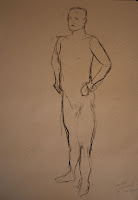These were rapid sketches ranging from about 3 to 5 minutes, and I was surprised at how much easier it was to obtain reasonable proportions I(I think) for most of them without measuring. I felt like my confidence had grown markedly.
- How well have you managed to capture the poses? What could be improved?
 I scrutinized levels, angles and positions of each area in relation to one another, such as which way the head was tilted, mostly judging by eye and concentrating on the negative spaces. I needed my model to hold each pose for up to 5 minutes, so a moving pose like walking or lifting an arm had to be held for longer than usual. Apart from this, I couldn’t realistically expect him to hold any poses which would have been difficult for around 5 minutes, so certain props were used as supports for a raised arm, when leaning forward and with one leg raised for instance – which would probably be impossible for most people to hold for this long. Under the circumstances I think I managed to capture the poses (limited as they are) and get them to look convincing: he does appear to be leaning on something. Sometimes the proportions were out, especially the shape and width of some limbs. I tried to include just an impression of the hands but in the main they tend to look chunky and clumsy and as though the model is wearing mittens. Leaving them look more unfinished, with a lighter outline may have helped to avoid this problem and and given more of a sense of energy.
I scrutinized levels, angles and positions of each area in relation to one another, such as which way the head was tilted, mostly judging by eye and concentrating on the negative spaces. I needed my model to hold each pose for up to 5 minutes, so a moving pose like walking or lifting an arm had to be held for longer than usual. Apart from this, I couldn’t realistically expect him to hold any poses which would have been difficult for around 5 minutes, so certain props were used as supports for a raised arm, when leaning forward and with one leg raised for instance – which would probably be impossible for most people to hold for this long. Under the circumstances I think I managed to capture the poses (limited as they are) and get them to look convincing: he does appear to be leaning on something. Sometimes the proportions were out, especially the shape and width of some limbs. I tried to include just an impression of the hands but in the main they tend to look chunky and clumsy and as though the model is wearing mittens. Leaving them look more unfinished, with a lighter outline may have helped to avoid this problem and and given more of a sense of energy.Do your figures look balanced? If not where did you go wrong?
I wasn’t aware of this fact when I did the sketches, but I since found out the shoulders and hips should tilt in opposite directions when the weight is taken on one foot. Strangely enough they do mostly appear to balance correctly, even though I didn’t check their angles with a pencil held at arm’s length this time. Albeit is hardly perceptible and in the side views I find it impossible to tell whether they are correct or not. I can also see that a straight vertical balance line usually ends up near the weight bearing foot. On the leaning pose some of the weight is taken by the arms and upper body so it would fall (as it does) some distance away from the feet.
How did you convey a sense of energy?
By working quickly from the start, drawing rapid broken lines with some undulations and following the direction of the gesture while studying the bend and curve of the limbs. The lines though could be more energetic and sweeping than they are; at the same time I was trying to juggle thinking in terms of cylinders, spheres and egg shapes to establish form. Where there are dense solid lines the model looks more static. Most poses weren’t very dynamic – couldn’t get model to hold tiring poses like twisting at all, or holding an arm in the air or leg off the ground without support for 5 mins. For conveying energy I think the first of the energy sketches looks most convincing as the model appears to be walking briskly when in fact he was standing still.
Stance

 |
| Energy 1 |
Energy
 |
| Energy 2 |
 |
| Energy 3 |
 |
| Energy 4 |



No comments:
Post a Comment